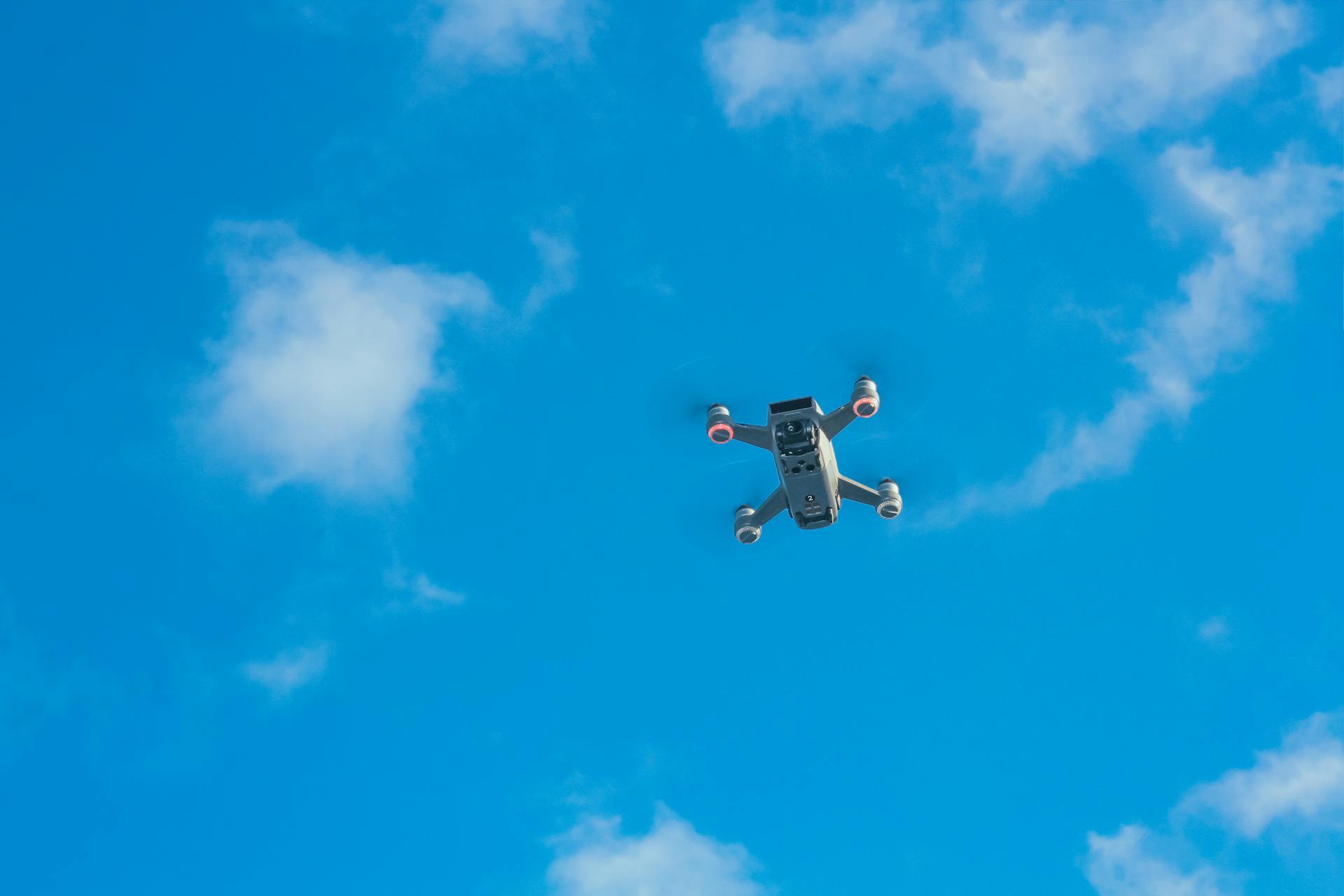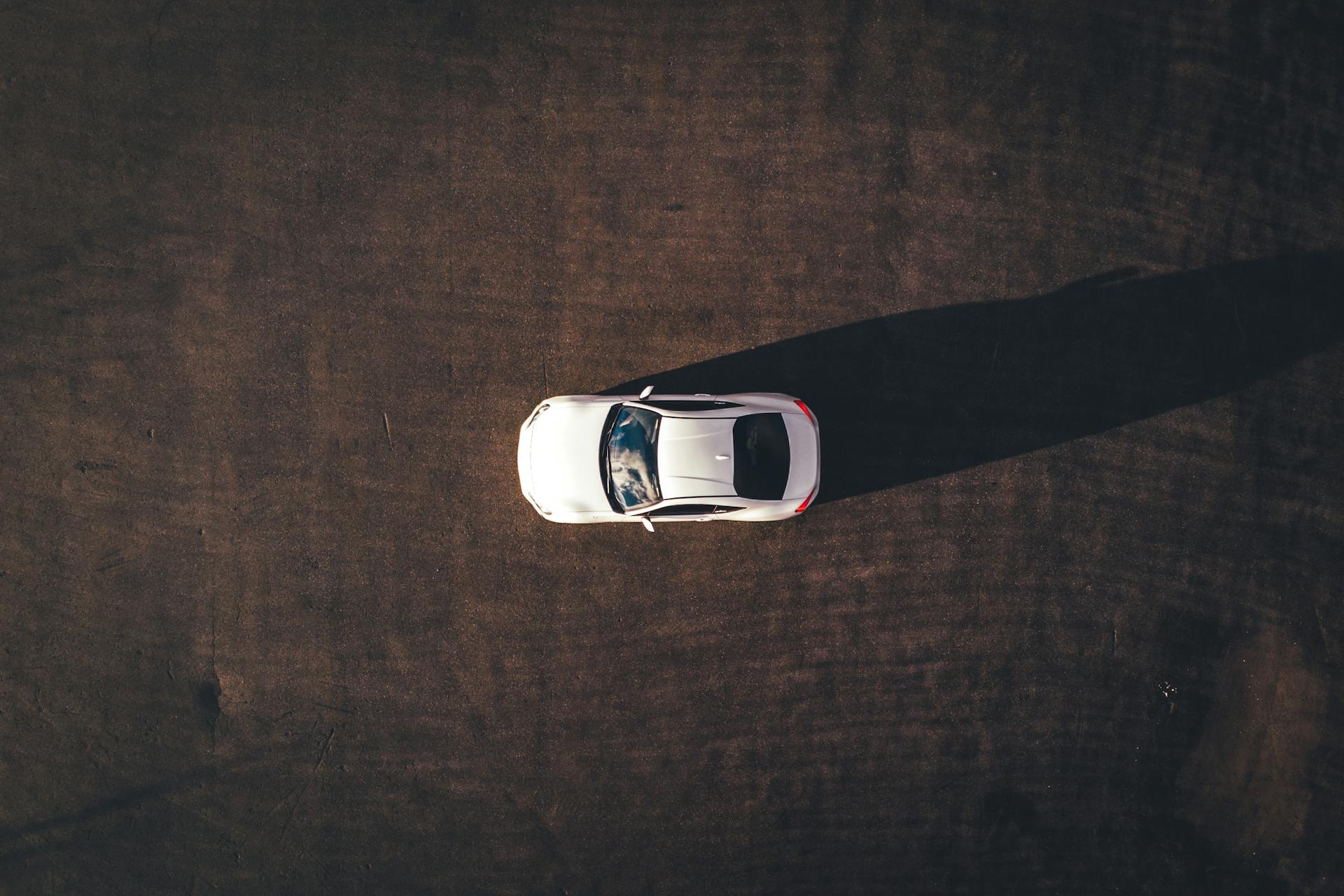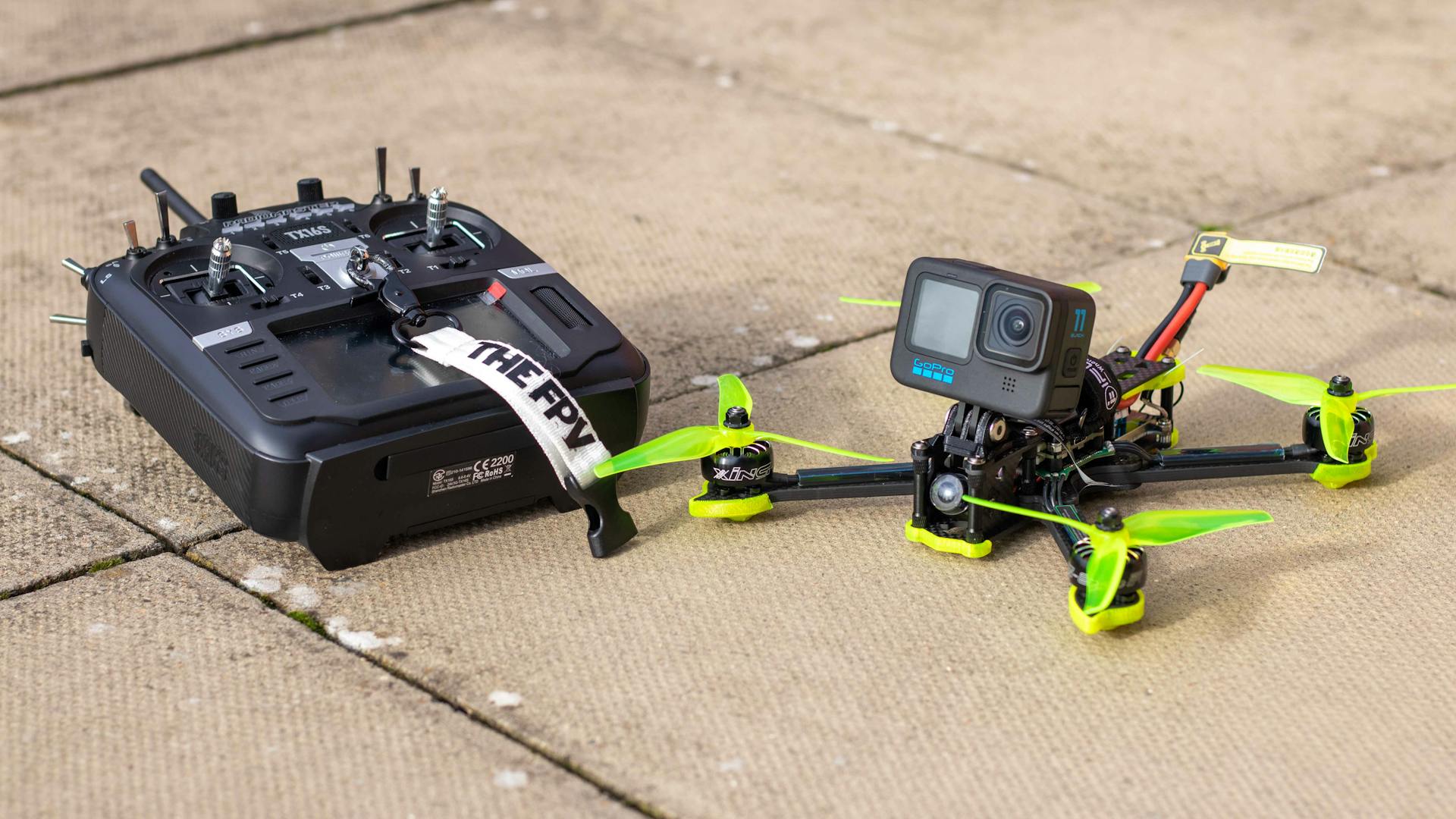
In the United Kingdom, UAVs are subject to strict regulations to ensure public safety and security. The UK Civil Aviation Authority (CAA) is responsible for overseeing the safe operation of UAVs.
The CAA requires UAV operators to register their drones with the UK Drone and Model Aircraft Register, a mandatory online database. This register helps authorities track UAVs and their operators.
To operate a UAV in the UK, you must be at least 13 years old and have permission from the landowner or have a permit from the CAA.
Worth a look: Regulation of UAVs in the United States
Regulated Drone Activity
Flying a drone in the UK is a regulated activity that requires you to follow certain rules to avoid any issues. The Civil Aviation Authority (CAA) has created a "Drone code" that serves as a guide for safe drone operation.
The CAA's "Drone code" is formed by the acronym DRONE, which stands for Don't fly near airports or airfields, Remember to stay below 400 feet, Observe your drone at all times, and Enjoy responsibly. This code is a great starting point for beginners.
You'll also need to obtain an "Operator" ID and "Flyer ID" from the CAA before using your drone. These IDs are awarded after passing an online theory test, and children under 18 can be registered as flyers of their parent or legal guardian's drone by passing the same test.
To fly a drone or model aircraft that weighs between 250g and 500g, you can fly closer to people than 50m if you get the A2 Certificate of Competency (A2 CofC). However, you still must not intentionally fly over people.
Here's a quick summary of the regulations:
- Don't fly near airports or airfields
- Stay below 400 feet
- Observe your drone at all times
- Enjoy responsibly
- Obtain an Operator ID and Flyer ID from the CAA
- Display your Operator ID on your drone
- Renew your Flyer ID every three years and Operator ID annually
- Don't intentionally fly over people
Legislation and Compliance
Legislation and Compliance is a crucial aspect of UAV regulation in the UK. The Air Navigation Order (ANO) 2016 sets out key safety principles, including not recklessly or negligently acting in a manner likely to endanger an aircraft or any person in an aircraft.
The Basic Regulation (BR) 2018/1139, the UAS Implementing Regulation (IR) 2019/947, and the UAS Delegated Regulation (DR) 2019/945 are also laws dedicated to UAS operations. These regulations outline specific requirements for safe UAV operations.
Here's an interesting read: Regulation of Unmanned Aerial Vehicles
Acceptable Means of Compliance and Guidance Material (AMC&GM) is guidance material provided by the CAA to help interpret the law correctly. However, it's essential to note that AMC&GM is not law per se, and other means of compliance may be possible.
Here are the key laws and regulations to consider:
- ANO Art 240: Endangering safety of an aircraft
- ANO Art 241: Endangering safety of any person or property
- Basic Regulation (BR) 2018/1139
- UAS Implementing Regulation (IR) 2019/947
- UAS Delegated Regulation (DR) 2019/945
History
In August 2012, The UK's Civil Aviation Authority (CAA) stated that it would require non-military drones larger than 20 kg to be able to automatically sense other aircraft and steer to avoid them.
The CAA requires UAV aircraft less than 20 kilograms in weight to be in direct visual contact with the pilot.
UAVs under 20 kg cannot fly within 150 meters of a congested area or within 50 meters of a person or vehicle, and cannot be used for commercial activity.
In July 2018, the CAA forbade flying above 400 feet (120 m) and flying within 1 kilometre (0.62 mi) of an airport or airfield boundary.
Flights were canceled at Gatwick Airport between 19 and 21 December 2018, following reports of drone sightings close to the runway.
Roles and Responsibilities
Roles and Responsibilities are crucial in Unmanned Aerial Systems (UAS) operations. There's a clear distinction between the UAS Operator and the Remote Pilot.
The UAS Operator is legally accountable for the safe management of the aircraft, deciding the necessary level of preparation, training, planning, and oversight for each flight.
In an organisation, the Operator is the company or legal entity, while the remote pilot is the individual flying a mission. This distinction is essential for compliance with laws and regulations.
There is no distinction between recreational or commercial operations, all pilots and operators must comply with the law. This means that individual pilots are both the pilot and the operator, and parents may be the operators while their under-age kids are remote pilots.
Here's a breakdown of the roles and responsibilities:
- The UAS Operator is responsible for the overall management of the aircraft.
- The Remote Pilot is responsible for carrying out the flight safely within the management framework set out by the Operator.
This means that the Operator must ensure effective management oversight for all flights using their aircraft.
Legislation
The legislation surrounding drone operations in the UK is quite complex, but don't worry, I'm here to break it down for you. The Air Navigation Order (ANO) 2016, as amended, is the primary law governing crewed aviation, and some of its principles also apply to uncrewed aircraft.
The ANO sets out key safety principles, including the prohibition on recklessly or negligently acting in a manner likely to endanger an aircraft or any person in an aircraft (ANO Art 240). It also prohibits recklessly or negligently causing or permitting an aircraft to endanger any person or property (ANO Art 241).
There are also specific laws dedicated to UAS operations, including the Basic Regulation (BR) 2018/1139, the UAS Implementing Regulation (IR) 2019/947, and the UAS Delegated Regulation (DR) 2019/945. These regulations are also considered law and govern various aspects of UAS operations.
Here are some key laws and regulations to keep in mind:
It's essential to note that these laws and regulations apply to all UAS operators, regardless of whether they're operating for recreational or commercial purposes.
Insurance Requirements
Insurance Requirements are crucial, especially when it comes to ensuring regulatory compliance.
To meet these requirements, you must have insurance that is EC 785 2004 compliant, which is a document that outlines the necessary insurance cover for non-recreational flights.
Non-recreational flights, by definition, are not for sport or leisure, so it's essential to have the right insurance in place.
Guidance and Requirements
Legislation, Acceptable Means of Compliance and Guidance Material, or AMC&GM, are guidance materials provided by the CAA to help interpret the law correctly.
You can't fly without understanding the law, so it's essential to familiarize yourself with the hierarchy of regulation, which includes CAPs, AMC&GM, and the law itself.
AMC&GM is not law per se, but it's highly recommended to comply with it, as the CAA is developing its corpus of AMC&GM.
In the UK, you can fly unmanned aircraft up to 25 kg within 150 metres of any residential, commercial, industrial, or recreational area.
However, you must maintain a minimum of 50 metres away from any un-involved person, except during takeoff and landing, where you can reduce that separation distance down to 30 metres.
To ensure you're compliant with insurance requirements, you must have insurance cover that meets the regulatory requirements as laid down in EC 785 2004.
Check this out: Unmanned Drones for Law Enforcement
Drones and Model Aircraft
Flying a drone is a regulated activity in the UK, so make sure to check the Civil Aviation Authority's (CAA) drone webpage for the most up-to-date information.
Drones and model aircraft below 250g have different rules for minimum distances to people. You can fly them closer to people than 50m, but you still can't fly over crowds.
Flying a drone or model aircraft that's below 250g can be done safely, but you must never put people in danger. Even small drones and model aircraft could injure people if you don't fly them safely.
If you're flying a drone or model aircraft that's between 250g and 500g, you'll need to get the A2 Certificate of Competency (A2 CofC) to fly closer to people than 50m. You still must not intentionally fly over people.
Restrictions and Hazards
Flying may be restricted around some sites, such as prisons, military ranges, royal palaces, and government buildings. These restrictions are in place to ensure public safety and security.
You must keep out of the way and not fly in any way that could hamper the emergency services when they're responding to an emergency incident. This includes stopping flying immediately if you're near an emergency incident unless the emergency services give you permission to continue.
Temporary restrictions may be put in place during events like airshows or festivals to keep everyone safe. You should follow any temporary restrictions that are put in place.
Byelaws may restrict when you can fly and where you can fly from. These byelaws are unlikely to be shown on apps or drone websites, so it's essential to look out for local signs and contact details to find out more.
Be aware of tall structures like cranes, masts, and wires that could interfere with your flight. If there are structures in the area that will mean it's not safe or legal to fly, don't attempt to do so.
Some Sites of Special Scientific Interest (SSSI) may have restrictions on flying to protect animals and wildlife. Check the web or look out for local signs to find out if there are any restrictions in place.
If you're flying near an emergency incident, be prepared to respond in the safest way possible if other aircraft appear where you're flying. This includes being aware of air ambulances, police helicopters, light aircraft, military aircraft, crop spraying, and electricity pylon surveying.
Useful resources to check for restrictions and hazards include:
- Checking for signs that say you cannot fly drones or model aircraft.
- Using drone apps that show airspace restrictions.
- Visiting the NATS drone website for official notices (NOTAMs) about activities that may be a hazard to flying.
- Consulting the Aeronautical Information Publication for more information on flight restrictions.
Flight Restriction Zones (FRZs) may also apply, and you'll need permission from Air Traffic Control or another authorising body to fly within them. Always check for FRZs before flying.
Sources
- https://en.wikipedia.org/wiki/Regulation_of_UAVs_in_the_United_Kingdom
- https://www.arpas.uk/industry-information/a-short-guide-to-uk-drone-regulation/
- https://register-drones.caa.co.uk/drone-code/where-you-can-fly
- https://blog.uavhub.com/what-is-pdra-01-uk-drone-regulations-explained
- https://www.lexology.com/library/detail.aspx
Featured Images: pexels.com


